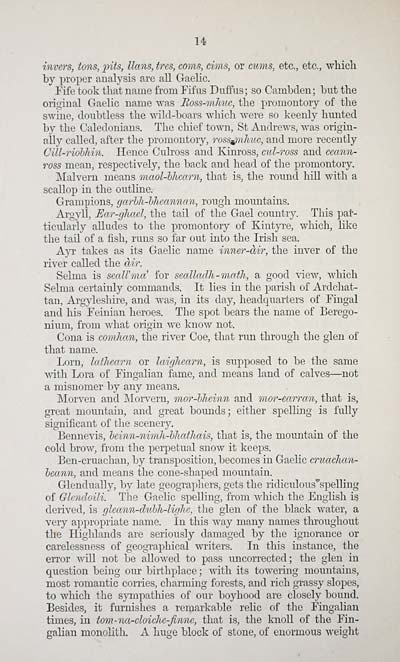Blair Collection > On the antiquity of the Gaelic language shewing its affinity to Hebrew, Greek, and Latin, superseding the Masoretic points, and furnishing a key to the Hebrew vowel sounds
(42)
Download files
Complete book:
Individual page:
Thumbnail gallery: Grid view | List view

14
invers, tons, ints, Hans, ires, corns, cims, or cums, etc., etc., wliicli
by proper analysis are all Gaelic.
Fife took that name from Fifus Duffus; so Cambden; but the
original Gaelic name was Ross-mhuc, the promontory of the
swine, doubtless the wild-boars which were so keenly hunted
by the Caledonians. The chief town, St Andrews, was origin-
ally called, after the promontory, ross^nhuc, and more recently
Cill-riohhin. Hence Culross and Kinross, ctd-ross and ceann-
ross mean, respectively, the back and head of the promontory.
Malvern means maol-hhearn, that is, the round hill with a
scallop in the outline.
Grampions, garhli-bheannan, rough mountains.
Argyll, Uar-ghael, the tail of the Gael country. This par-
ticularly alludes to the promontory of Kintyre, which, like
the tail of a fish, runs so far out into the Irish sea.
A}t: takes as its Gaelic name inner-air, the inver of the
river called the air.
Selma is seaU'ma' for sealladh-math, a good \'iew, which
Selma certainly commands. It lies in the parish of Ardchat-
tan, Argyleshire, and was, in its day, headquarters of Fingal
and his Feinian heroes. The spot bears the name of Berego-
nium, from what origin we know not.
Cona is comhan, the river Coe, that run through the glen of
that name.
Lorn, lathearn or laighearn, is supposed to be the same
A\4th Lora of Fingalian fame, and means land of calves — not
a misnomer by any means.
Morven and INIorvern, mor-bheinn and mor-earran, that is,
great mountain, and great bounds; either spelling is fully
significant of the scenery.
Bennevis, leinn-nimh-hhatlmis, that is, the mountain of the
cold brow, from the perpetual snow it keeps.
Bcn-cruachan, by transposition, becomes in Gaelic cruaclian-
heann, and means the cone-shaped mountain.
Glendually, by late geographers, gets the ridiculous'spelling
of Glcndoili. The Gaelic spelling, from which the English is
derived, is gleann-chchh-lif/hc, the glen of the black water, a
very appropriate name. In this way many names throughout
the Highlands are seriously damaged by the ignorance or
carelessness of geographical writers. In this instance, the
error will not be allowed to pass uncorrected; the glen in
question being our birthplace ; with its towering mountains,
most romantic corries, charming forests, and rich grassy slopes,
to which the sjonpathies of our boyhood are closely bound.
Besides, it furnishes a remarkable rehc of the Fingalian
times, in tom-na-cloiche-finnc, that is, the knoU of the Fin-
galian monolith. A huge block of stone, of enormous weight
invers, tons, ints, Hans, ires, corns, cims, or cums, etc., etc., wliicli
by proper analysis are all Gaelic.
Fife took that name from Fifus Duffus; so Cambden; but the
original Gaelic name was Ross-mhuc, the promontory of the
swine, doubtless the wild-boars which were so keenly hunted
by the Caledonians. The chief town, St Andrews, was origin-
ally called, after the promontory, ross^nhuc, and more recently
Cill-riohhin. Hence Culross and Kinross, ctd-ross and ceann-
ross mean, respectively, the back and head of the promontory.
Malvern means maol-hhearn, that is, the round hill with a
scallop in the outline.
Grampions, garhli-bheannan, rough mountains.
Argyll, Uar-ghael, the tail of the Gael country. This par-
ticularly alludes to the promontory of Kintyre, which, like
the tail of a fish, runs so far out into the Irish sea.
A}t: takes as its Gaelic name inner-air, the inver of the
river called the air.
Selma is seaU'ma' for sealladh-math, a good \'iew, which
Selma certainly commands. It lies in the parish of Ardchat-
tan, Argyleshire, and was, in its day, headquarters of Fingal
and his Feinian heroes. The spot bears the name of Berego-
nium, from what origin we know not.
Cona is comhan, the river Coe, that run through the glen of
that name.
Lorn, lathearn or laighearn, is supposed to be the same
A\4th Lora of Fingalian fame, and means land of calves — not
a misnomer by any means.
Morven and INIorvern, mor-bheinn and mor-earran, that is,
great mountain, and great bounds; either spelling is fully
significant of the scenery.
Bennevis, leinn-nimh-hhatlmis, that is, the mountain of the
cold brow, from the perpetual snow it keeps.
Bcn-cruachan, by transposition, becomes in Gaelic cruaclian-
heann, and means the cone-shaped mountain.
Glendually, by late geographers, gets the ridiculous'spelling
of Glcndoili. The Gaelic spelling, from which the English is
derived, is gleann-chchh-lif/hc, the glen of the black water, a
very appropriate name. In this way many names throughout
the Highlands are seriously damaged by the ignorance or
carelessness of geographical writers. In this instance, the
error will not be allowed to pass uncorrected; the glen in
question being our birthplace ; with its towering mountains,
most romantic corries, charming forests, and rich grassy slopes,
to which the sjonpathies of our boyhood are closely bound.
Besides, it furnishes a remarkable rehc of the Fingalian
times, in tom-na-cloiche-finnc, that is, the knoU of the Fin-
galian monolith. A huge block of stone, of enormous weight
Set display mode to: Large image | Transcription
Images and transcriptions on this page, including medium image downloads, may be used under the Creative Commons Attribution 4.0 International Licence unless otherwise stated. ![]()
| Permanent URL | https://digital.nls.uk/80954384 |
|---|
| Description | A selection of books from a collection of more than 500 titles, mostly on religious and literary topics. Also includes some material dealing with other Celtic languages and societies. Collection created towards the end of the 19th century by Lady Evelyn Stewart Murray. |
|---|
| Description | Selected items from five 'Special and Named Printed Collections'. Includes books in Gaelic and other Celtic languages, works about the Gaels, their languages, literature, culture and history. |
|---|

